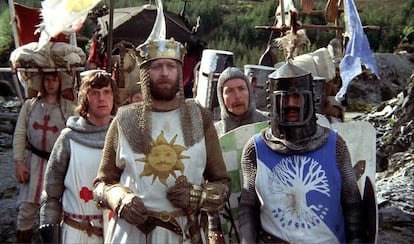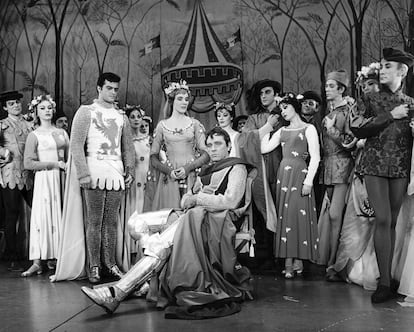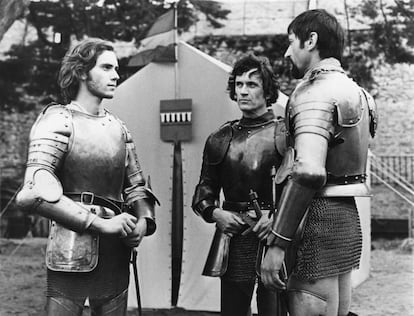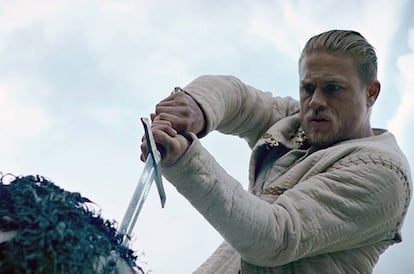New life for the Round Table, Camelot, the Grail, and Excalibur: a novel joyfully reimagines Arthurian legend

Another book about Arthurian legend ? Not at all: The Blade of Glitter (Destino, 2025), by Lev Grossman, an accredited fantasy author, is a highly entertaining and astonishing novel that gives a joyful twist to the myths of the Round Table, Camelot, the Grail and Excalibur. It comes accredited by excellent reviews and the recommendations of dragonera Rebecca Yarros , Joe Abercrombie and none other than George RR Martin (“you will hallucinate”). It is worth noting that Grossman also places himself under the invocation of The Black Book of Carmarthen ( Llyfr Du Caerfyrddin ), the oldest manuscript in Welsh (1250), with references to Arthur, Merlin and the Battle of Llongborth (“At Llongborth I saw the heroes / of Arthur cut with steel”); and, in another more popular and geeky register, that of The Knights of the Round Table and his mad followers , the hilarious Arthurian reinterpretation of Monty Python , and from which the author selects an unforgettable quote as the heading of his novel: “That a strange woman decides to come out of a lake to distribute swords is not the basis for a system of government.”
The Flashing Blade , a wonderful blend of academic Arthurian orthodoxy (Gossman is very familiar with the corpus) and healthy subversion, with a boundless imagination and a dose of humor, begins with a young, inexperienced, somewhat uncouth bastard with stolen armor and horse, Collum (later Sir Collum of the Hebrides), heading to Camelot in pursuit of his dream of becoming a Knight of the Round Table and serving King Arthur. Along the way, he already faces a mysterious knight in a duel that will determine his destiny. But when he arrives at Camelot, of high towers and immortal fame, he finds a bleak scene: the great hall is almost deserted, and around the enormous table there is not the chivalrous throng he imagined, headed by the famous Gawain, Perceval, Galahad, Tristan and Lancelot, but only a handful of grieving knights: the Saracen Sir Palomides, Villiars the Valiant, Sir Bedivere, maimed in his left hand, Sir Dinadan and Sir Constantine. They inform him that King Arthur is dead (“he fell at Camlann with most of the Round Table”) and that they are all that remain, and they literally send him “to hell,” an expression we will not find in Geoffrey of Monmouth, Thomas Malory or Chrétien de Troyes.
What follows is a series of adventures in which Collum and his new friends, in search of “a new sword, a new stone,” will travel through the abyssed Britain at the end of an era, visit the Otherworld and Morgana le Fay and her fairies and goblins, Avalon (where Arthur himself awaits his return), meet Queen Guinevere (at the helm of a flying ship), Merlin, and an evil Lancelot. Meanwhile, Grossman recounts the lives of the knights who participate in this final quest , which serves to recall the Arthurian world that has ended. It is worth noting that of these knights, characters credited in the sources to whom the author gives an interesting and personal twist, Palomides, Prince of Baghdad, is a Muslim emigrant; Dinadan is transgender (she is actually a girl, like Clorinda in Tasso's Jerusalem Delivered ), Sir Dagonet (Arthur's dwarf jester turned knight) suffers from a physical disability, and, above all, the other great protagonist with Collum, Bedivere, is gay, having been secretly in love with Arthur all his life.
The novel has passages that rival the Arthurian material in terms of fantasy: the duel between the sorceress Nimue and her master Merlin (with some moments reminiscent of the fight between the sorcerer and Madame Mim in the Walt Disney film), the Green Knight's appearance in Camelot, or the rescue itself on the flying ship.
“I've always been interested in the Arthurian legend as a reader, and I thought everything had already been said, but I discovered there were things that hadn't been said, that Arthur still had things to say,” explains Lev Grossman (Lexington, Massachusetts, 56) in a video interview that reveals a container on a shelf that resembles the grail from Indiana Jones and the Last Crusade . The novelist laughs as he points it out. “It does look like it! It's purely a coincidence, but you have to see how Arthurian symbols merge into your life.” Grossman continues: “My Arthur was T.H. White’s (1906–1964), who adapted Malory. White was homosexual, but given the era, he could only write about heterosexual relationships. I saw that there was a whole world of emotional experiences that he couldn’t express and capture: the world wasn’t ready for a gay knight at the Round Table then, but it is now. And also a trans one, and another who wasn’t white and Christian, and yet another with mental health issues. The time had come to bring them out, to give them a chance to explain themselves.”

Grossman adds that the Arthurian legend has always been seen as a tragedy that ends with the death of the king. “But there are other ways to tell the story . What if we kept the cameras rolling and saw what happened next? What was it like for those who remained alive after King Arthur’s traumatic end of the world? They had to rebuild themselves in the world he left behind. Telling that is a different story, and I wanted to do it.” The Flashing Sword moves between drama and comedy, sometimes bordering on Monty Pythonism . “It comes very close at times,” Grossman laughs again. “Humor is very important to me. It helps turn these characters from the Arthurian corpus, who have come down to us exhausted after a thousand years, who had ceased to be living people, into human beings. I wanted them to talk to each other like real people would, with their jokes and gags.”
In that sense, he's upended Malory and Tennyson, so serious and transcendent, but the characters in The Flashing Blade are also harsh and ruthless, and there are harrowing battles. "It's true, that was the time, a very cruel moment, in which death was always near, and I also wanted to reflect that. I took great care to convey physical sensations, like holding a sword in your hand or wearing armor. We know more about all that now than when T. H. White or Steinbeck were writing. I wanted it to be like in Martin's novels, where you feel the pain and see the blood. A very physical world that contrasts with the unattainable ideal of the grail."
There are passages that show a good understanding of medieval fighting techniques and fencing. Watching your opponent's body, not their sword, positions like the Ploughshare, the heat you spend under a helmet, finishing off an opponent by stabbing them in the eye through the slit in a helmet; wearing your hair long for extra padding; or Collum carrying a small hammer and metal file to fix dents in his armor. "There are people today who practice the martial arts of European chivalry, and I've taken some classes. I wanted to experience and understand what it was like to fight with a two-handed sword, to immerse myself in the dance of precise movements in combat, to hear the sound of a sword cutting through the air, or where you get calluses when you wield it. Those details."

However, The Flashing Sword is not at all a realist and historicist novel, as was the recreation of the legend that Bernard Cornwell made from the evemerism in the phenomenal trilogy Chronicles of the Warlord (with a Lanzarote who was the bad guy of the show, precisely). “Cornwell's version is splendid. I wouldn't have done it as well and decided to do the opposite, opting more for the romantic and fantastic. Mine is a dreamlike fantasy woven from all the components of the Arthurian world, that mosaic in which there are early medieval parts, with echoes of a 6th-century Arthur who perhaps existed (I won't enter into the debate) as a warlord in a world where there were no castles, which arrived much later with the Normans, nor glittering armor. I use the confrontation between the old religion of the Druids and that of Christianity, with its own dark God, and also all the late medieval wonder, with its pageantry, its Camelot, its faerie and courtly atmosphere. Layers and layers. I took things from here and there, the Table, the adultery of Lancelot and Guinevere, the Grail, and in the novel there are anachronisms and contradictions, as in the Arthurian canon itself. A mishmash of a thousand and something.” of years of British history and legend.”
In any case, Grossman is comfortable with fantasy. “I come from that world; my novel is undoubtedly fantasy, although in the end I return to a certain historical orthodoxy by depicting the final Saxon invasion. The Flashing Sword is in some ways a journey between the heroic Arthur and the one who could have been real, the historical one, let's say.” Tolkien? “I wanted to go further back; Tolkien was interested in the Saxon and not so much in the Celtic, the pre-Roman, which is where my story delves.” Grossman, however, acknowledges the influence of Robert Graves's The White Goddess (there are references to the Druid alphabet in which each letter was a tree). “It's a difficult book with a scholarship that doesn't appeal to academics, and yet it's very inspiring. In my novel, there's a certain vibe , a feeling, or an energy of that work by Graves.”

The reference to Excalibur (1981) , John Boorman 's great film, from which Grossman draws the concept of the king's health being equal to that of the kingdom, or the ambiguity of the Grail, is unavoidable. "Like many people of my generation, I saw the film when I was too young to fully understand it. It has become part of the tradition to which The Flashing Blade owes much; overcoming its scenes is very difficult, which is why I also use the option of widening the lens and looking for a story to tell after Arthur's death."
The importance of women in the novel also shows the influence of Marion Zimmer Bradley's popular retelling of The Mists of Avalon (1982) series of novels. "Her shadow is very long and also transformed Arthurian tradition," Grossman notes. "Putting women at the center of the narrative as I do in my novel comes from there and isn't original, but in part it's because in the Arthurian tale, men die and women survive, and they also have a great power different from men. I wanted to develop Guinevere's story above all, as she has her own agenda. Morgana, for her part, is also much more interesting than the role she's often reduced to as a villain and wicked witch; I see her as a representative of ancient Britain and a resistance fighter for the old traditions."
Merlin is the father and teacher we would all like to have, but he has a very dark side.
Merlin, on the other hand, doesn't come off very well. "I love Merlin! In part, he's the father and teacher we all wish we had. But he has a dark side; he sexually harasses his apprentice, Nimue. Where does Merlin come from? He's clearly a druid who, paradoxically, lives and works in the court of a Christian king. He's an amoral person who does whatever it takes to advance and accumulate power. My Merlin is sinister. I miss the other one." And Lancelot? "He's complicated; he spent his childhood serving the Lady of the Lake in what must not have been a very healthy environment. He's obsessed with excellence, and that shows he has a void he's unable to fill. There's something dark and painful about that drive for perfection that drives Lancelot, and it has to do with God. Ultimately, being Lancelot is fatal." It's fashionable to revisit the love stories of Lancelot and Guinevere . “I never found that love believable, sorry. I don't understand the essence of that attraction. Love, love? I don't think so.”
One of the key elements of Grossman's reinterpretation is the gay knight, Sir Bedivere. "It's one of the stories I was convinced needed to be told. There are gay people on every team, and there were certainly some at the Round Table. What would that be like, being gay among King Arthur's knights? I'd have to hide it. That hiding would be a lonely and sad experience. There was a very human story of longing and shame that was very interesting and moving."

As for the aesthetic influences on her novel, “the Pre-Raphaelites , of course, and the Romantic painters… My reference has been to look for something beautiful and wonderful, not dystopian or grotesque. It's a story with knights, ladies, fairies, and angels.”
After that long journey of The Flashing Blade (812 pages), have you discovered anything about the Grail? What is the Grail? “Great question. The Grail is a fundamental part of the story, of course. At the beginning, I thought the Grail was the great adventure of King Arthur’s knights and their triumph, but I realized it actually meant the destruction of Camelot. God tested them, and most of them failed. And then he abandoned them, became a distant being, and there were no more wonders and adventures. The Grail was the beginning of the end for Arthur, for his knights, and for his world.”
EL PAÍS





